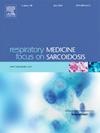Comorbidities as treatable traits of chronic airway diseases
IF 3.1
3区 医学
Q2 CARDIAC & CARDIOVASCULAR SYSTEMS
引用次数: 0
Abstract
Chronic airway diseases, including asthma, chronic obstructive pulmonary disease, and bronchiectasis, are increasingly recognized as heterogeneous conditions influenced not only by airway pathology but also by a wide range of extrapulmonary and behavioral comorbidities. The treatable traits (TT) model, as it has emerged in recent medical literature, offers a precision medicine framework that redefines comorbidities as clinically relevant, identifiable, and modifiable traits. This paradigm shifts the focus from conventional disease labels to a multidimensional approach that considers the individual's unique constellation of pulmonary, extrapulmonary, and psychosocial features. A growing body of research has identified critical targets for intervention. The efficacy of this approach is supported by evidence from clinical trials and real-world studies. These studies demonstrate that trait-based management, especially when incorporating comorbidities, results in improved disease control, reduced symptom burden, enhanced quality of life, and decreased frequency of exacerbations. The implementation of multidimensional assessment tools and multidisciplinary care models is imperative for operationalizing this strategy within both primary and secondary care settings. Future directions for this field include leveraging artificial intelligence and machine learning to refine trait identification and predict individualized treatment responses. Longitudinal studies and adaptive trial designs are also necessary to evaluate the long-term effectiveness, cost-efficiency, and scalability of trait-based interventions across diverse healthcare systems. The recognition of comorbidities as TTs signifies a substantial advancement in the delivery of holistic, patient-centered care for individuals with chronic airway diseases.
合并症作为慢性气道疾病的可治疗特征
慢性气道疾病,包括哮喘、慢性阻塞性肺疾病和支气管扩张,越来越被认为是一种异质性疾病,不仅受到气道病理的影响,还受到广泛的肺外和行为合并症的影响。在最近的医学文献中出现的可治疗特征(TT)模型提供了一个精确的医学框架,将合并症重新定义为临床相关的、可识别的和可改变的特征。这种模式将焦点从传统的疾病标签转移到考虑个体独特的肺、肺外和社会心理特征的多维方法。越来越多的研究已经确定了干预的关键目标。这种方法的有效性得到了临床试验和现实世界研究的支持。这些研究表明,基于特征的管理,特别是当合并合并症时,可以改善疾病控制,减轻症状负担,提高生活质量,减少恶化频率。实施多维评估工具和多学科护理模式对于在初级和二级保健环境中实施这一战略至关重要。该领域的未来发展方向包括利用人工智能和机器学习来改进特征识别和预测个性化治疗反应。纵向研究和适应性试验设计对于评估不同医疗系统中基于特征的干预措施的长期有效性、成本效率和可扩展性也是必要的。将合并症视为慢性气道疾病,标志着为慢性气道疾病患者提供全面、以患者为中心的护理的重大进步。
本文章由计算机程序翻译,如有差异,请以英文原文为准。
求助全文
约1分钟内获得全文
求助全文
来源期刊

Respiratory medicine
医学-呼吸系统
CiteScore
7.50
自引率
0.00%
发文量
199
审稿时长
38 days
期刊介绍:
Respiratory Medicine is an internationally-renowned journal devoted to the rapid publication of clinically-relevant respiratory medicine research. It combines cutting-edge original research with state-of-the-art reviews dealing with all aspects of respiratory diseases and therapeutic interventions. Topics include adult and paediatric medicine, epidemiology, immunology and cell biology, physiology, occupational disorders, and the role of allergens and pollutants.
Respiratory Medicine is increasingly the journal of choice for publication of phased trial work, commenting on effectiveness, dosage and methods of action.
 求助内容:
求助内容: 应助结果提醒方式:
应助结果提醒方式:


